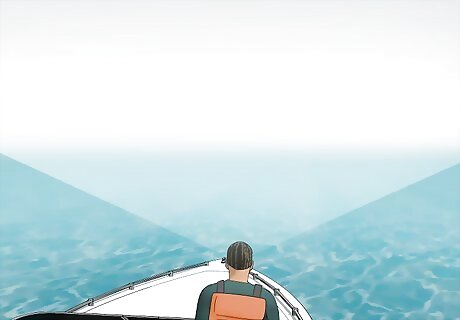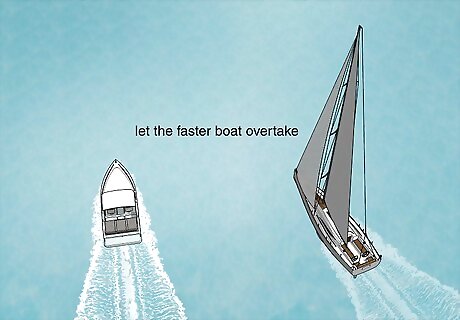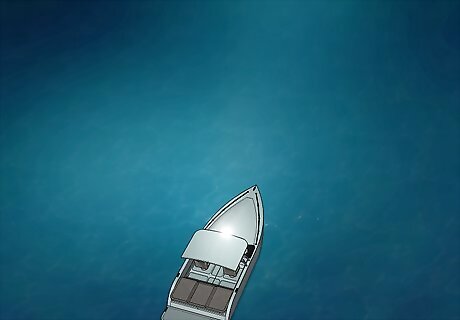
views
- Avoid collisions by being predictable. Don’t behave erratically, maintain a safe speed, and keep a lookout.
- Study and memorize the passing rules and signaling sounds. These are key rules of the road when it comes to navigating busy waters.
- Turn your lights on if it isn’t bright out and keep a VHF radio on and tuned to channel 16 so that other boats can warn you if you’re in danger.
Maintain an active lookout.

Actively scan the water for potential danger when you’re in motion. In a small recreational vehicle, the vessel operator must actively keep a lookout by scanning the horizon ahead. When you spot a boat coming in your direction, develop your plan for how you’ll safely change your course, overtake the boat, or allow them to pass. Look in all directions multiple times before making any turns. T On a larger boat with multiple crew members, there should always be a dedicated lookout (the same way there is a designated first mate, chief engineer, or captain).
Keep a safe speed.

Follow speed limit signs and don’t go faster than you need to. If there is no posted speed limit, there is no definition of what qualifies as a “safe” speed since it depends on your boat. As a rule of thumb, if you aren’t 100% in control of the boat, you’re going too fast. It’s rare that someone crashes because they were going to slow, but high speeds are one of the biggest risk factors out there for collisions, so be safe. As a general guidance, you’re typically going to be moving “too fast” on a boat with an engine if you’re going 20–30 mph (32–48 km/h)..
Abide by posted navigational aides.

Do not ignore signs, buoys, and posted instructions. If you see a sign and you can read it, do so. Warning signs will describe rocky outcrops, reefs, and restricted areas where you aren’t allowed to boat. Red and green buoys are lanes. Remember the 3 Rs, “Red is right when returning”—the red buoy always goes on your starboard (right) side when you’re returning to dock. Remember, if you’re in a kayak or canoe, you always stay on the outer edge on the right of the red buoys.
Follow the rules of the road.

There are a handful of axioms each type of boat must follow. Different vessel types have unique responsibilities when it comes to encountering another vessel. These are fundamental marine navigation rules that all skippers follow, so memorize the guidelines for your specific boat type. The rules are as follows: Boats with engines: Always turn starboard (right) when approaching vehicles head on or at an angle. You always give the right of way to other vessels.What Should You Do to Avoid Colliding with Another Boat Step 4Bullet1.jpg Sailboats: If you’re on a port (left) tack, give way to sailboats on a starboard (right) tack. When on the same tack, the vessel closest to the windward side must give way.What Should You Do to Avoid Colliding with Another Boat Step 4Bullet2.jpg Kayaks and rowboats: Stay to the right of red buoys and never enter main shipping channels. On busy water, you always stay on the shore side. Overtake on the right.What Should You Do to Avoid Colliding with Another Boat Step 4Bullet3.jpg All boats: Give way to boats being overtaken by another boat. It is your responsibility to give way to large ships and maintain a safe distance.What Should You Do to Avoid Colliding with Another Boat Step 4Bullet4.jpg
Give way to the faster boat.

As a rule of thumb, it’s the faster boat’s job to get out of the way. A sailboat going 15 miles per hour (24 km/h) should never expect an anchored powerboat to get out of their way. The reverse is equally true. It’s easier for a slower boat to maintain course and let the faster boat overtake them than the other way around, so do not make sudden movements if you’re being overtaken. The exception here is for large, commercial ships (i.e. shipping freighters, Navy frigates). It is always the recreational boat’s job to get out of the way, even if you’re going slower than they are.
Maintain your course while being overtaken.

If someone is passing you, avoid turning or changing directions. As tempting as it may be to “help” by getting out of the way, unexpected movement just freaks other boats out on the water. If someone is passing you (or getting out of your way), just stay your course. Don’t deviate if you’ve signaled or suggested by your behavior that you’re okay with someone passing you. Always be predictable. Other boats don’t know what’s going on in your head when you’re on the water, so remove as much guesswork as you can.
Learn the boating signals.

Those whistles and horns indicate a boat’s intentions. Horns and whistles on the water are called “blasts” and the patterns and durations of those sounds contain key info. Put a little laminated note next to the helm if you need help remembering these rules. As a note, “short blast” refers to a sound lasting 1 second or less. A “prolonged blast” lasts 4-6 seconds. Here are the signals: 1 short blast: “I want to pass you on my port side (your starboard side).” If you agree, reply with 1 short blast of your own.What Should You Do to Avoid Colliding with Another Boat Step 7Bullet1.jpg 1 prolonged blast: “I am leaving the dock” or “I am around the corner.” If you hear this from a corner, reply with 1 prolonged blast.What Should You Do to Avoid Colliding with Another Boat Step 7Bullet2.jpg 3 short blasts: “I am backing up or operating in reverse.”What Should You Do to Avoid Colliding with Another Boat Step 7Bullet3.jpg 1 prolonged blast + 3 short blasts: “I am departing a dock in reverse.”What Should You Do to Avoid Colliding with Another Boat Step 7Bullet4.jpg 5 short blasts: “Danger!” or, “I do not understand what you want to do.” This is basically a reset button for the other boat to indicate they are not safe to do whatever they’re trying to do. This is the equivalent of slamming on a car horn to avoid a collision.What Should You Do to Avoid Colliding with Another Boat Step 7Bullet5.jpg
Stay to the right side in rivers and channels.

Like driving in the US, you’re in the right lane in narrow waters. If you’re operating in a swamp with a narrow waterway, a river, or a two-way channel, always keep your boat on the right. Go with the flow of traffic in narrow rivers and channels. Don’t try to overtake anyone unless you’re 100% positive it’s safe to do so.
Stay out of shipping lanes.

Just keep your distance when you see giant container ships. Commercial ships use designated paths, known as shipping lanes, to travel predetermined routes. These are the highways of the sea. Refer to your nautical charts to determine where shipping lanes are if you’re doing any boating for an extended period of time. Otherwise, just steer clear of the giant tankers and ships. These huge ships take forever to change course, and they’re moving much faster than they appear on the horizon.
Keep your VHF radio on.

Boats may hail you via radio if you’re in harm’s way. If you’re boating in anything bigger than a kayak, canoe, or jet ski, you may want to invest in a VHF radio. Keep the radio on when you’re boating, and stay silent (unless you need to call something out). Channel 16 is the universal community channel, so stay on that and keep your ear out for boaters hailing you to move or watch out. If you ever need to call out distress or mayday, you do it on channel 16. When hailing another boat, tell them to move to a specific channel other than 16 (or 9) so that you don’t clog the public channels.
Stay visible on the water.

When it’s even a little dark out, keep your lights on at all times. Overcast skies, fog, snow, and a lack of light all call for you to turn your stern and bow lights on. If you’re in a smaller boat, you must use a flashlight or lantern. The more visible you are, the safer you’ll be when other boats are nearby. Depending on where you live, it may actually be illegal to take your boat out at night. Refer to your local laws for more info.




















Comments
0 comment